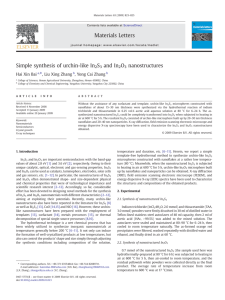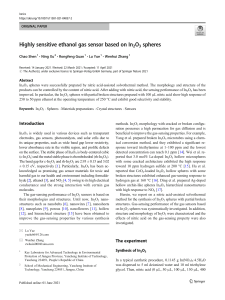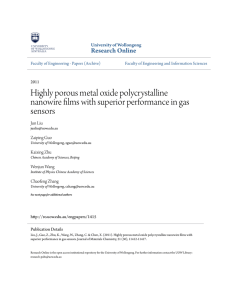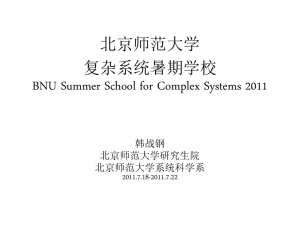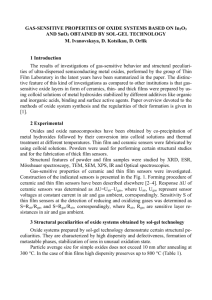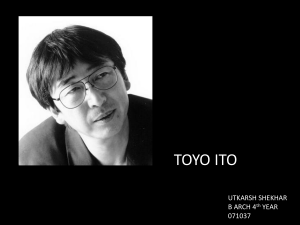Surface Study of In2O3 and Sn-doped In2O3 thin
advertisement
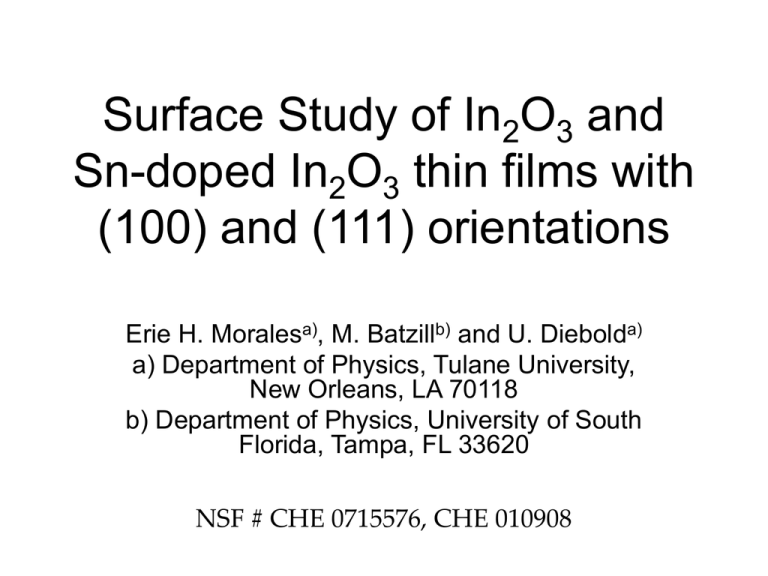
Surface Study of In2O3 and Sn-doped In2O3 thin films with (100) and (111) orientations Erie H. Moralesa), M. Batzillb) and U. Diebolda) a) Department of Physics, Tulane University, New Orleans, LA 70118 b) Department of Physics, University of South Florida, Tampa, FL 33620 NSF # CHE 0715576, CHE 010908 Motivation • Sn doped In2O3 is a Transparent Conducting Oxide • Besides being used in solar cells finds application in Organic Light Emitting Diodes as hole injector • Mostly used in polycristalline form • Orientation most studied is (100) • Few surfaces studies on any other low index orientation Characterization • Substrates and films where characterized using in situ RHEED, LEED and XPS • Also sample where characterized using UPS at Center for Advanced Microstructures and Devices, Baton Rouge Louisiana Preparation • Substrate – YSZ Yttrium Stabilized Zirconia, (Y 9%) – Cubic body centered, cube-on-cube epitaxy with In2O3 – Lattice parameter • YSZ is 0.5125 nm • In2O3 is 1.0117 nm – Substrate prepared by high temp treatment at 1350 C* * Hiromichi Ohta et al. Appl. Phys. Lett. 76 19 (2000) 2740-2742 RHEED Substrate Characterization In2O3 Crystal Structure • BCC a = 1.0117 nm • Substrate lattice mismatch is 1% • (100) has a polar character • (111) is not polar In2O3 Films • Films – – – – – – – UHV 5 10-10 mbar base pressure Molecular Beam Epitaxy In e-beam evaporated at 0.1 nm/min Oxygen Plasma Assisted at 15mA O2 at 5 10-6mbar O2 at 10-5 mbar Sn was co-evaporated using a Knudsen cell – Growth temperatures at 450, 550 and 800C, highest temp gives best results RHEED In2O3 Film LEED In2O3 & ITO (100) • In2O3 (100) facets • Sn doped In2O3 at different Sn concentrations from 11% to 3 % results in stabilization of the surface • 9% Sn shown ARXPS • Surface sensitive at higher polar angles. When rotating sample photoelectron would need to travel longer distance to surface. Considering IMFP only photoelectrons closer to surface manage to be detected ARXPS of In2O3 (100) and Forward Scattering Analysis 4x10 3x10 2x10 4 4 4 -5 5 15 25 35 45 55 65 Sn-doped In2O2 (100) Sn doped In2O3(100) Sn / (Sn + In) (%) 18 16 14 12 10 8 0 10 20 30 40 50 60 70 Polar Angle • Sn segregates to the surface Sn-doped In2O2 (111) 4 Sn / (Sn + In) % Sn-doped In2O3 (111) In 3d 3 2.4x10 Sn 3d 4 8.0x10 3 2.0x10 3 4 6.0x10 3 1.6x10 4 4.0x10 2 3 1.2x10 4 2.0x10 2 1 8.0x10 0 10 20 30 40 Polar Angle 50 60 0.0 0 10 20 30 40 50 60 Polar Angle • Sn does not segregate to surface, I measured this yesterday!!!, nice! LEED • YSZ(111) substrate and In2O3 at 103eV YSZ(111) In2O3 (111) 2x2 UPS • • Point is Sn derived states in the Band Gap Point is to correlate it to Sn segregation observed in XPS and the fact that UPS is surface sensitive corroborating Sn migration to the surface or Sn terminated surface Undoped In2O3 (100) 12 10 8 Sn-doped In2O3 (100) 39.77 37.77 35.69 33.61 31.60 29.62 27.67 25.75 23.83 21.83 6 BE(eV) 4 2 0 12 10 8 39.77 37.77 35.69 33.61 31.60 29.62 27.67 25.75 23.83 21.83 6 BE(eV) 4 2 0 Valence Band Maximum • Still an open question the measured VBM at 2.6 eV smaller than 3.7eV • Optical BG Direct and Indirect meas. by Weiher and Ley J. Appl. Phys 37 1 (1966) • UPS meas. by A. Klein et al. Phys. Rev. B 73 245312 (2006) VBM In2O3 (eV) ITO (eV) (100) 2.6 2.6 (111) 2.7 2.8 In2O3 & ITO (100) • Gap State and Resonant Photoemission of gap state 2000 (100) In2O3 ITO h = 30 1800 1600 Arb. U. (100) 1400 1200 1000 4 3 2 1 0 21 24 27 30 33 36 Photon Energy (eV) 39 Compare VB ITO (100) & (111) • Point is Sn derived states doesn’t show so clearly (100) 4 3 In2O3 ITO h = 30 2 1 In2O3 ITO h = 30 (111) 0 4 3 2 1 0 Conclusions & Outlook • • • • • Sn stabilizes the (100) surface so it doesn’t facet Sn replaces substitutionally In sites There are clear Sn derived states in Band Gap The position of the VBM is an open question Less clear Sn derived states in (111) corroborated by UPS and ARXPS • Do absorption experiments to see if Sn derived states move to the conduction band on (111) orientation
